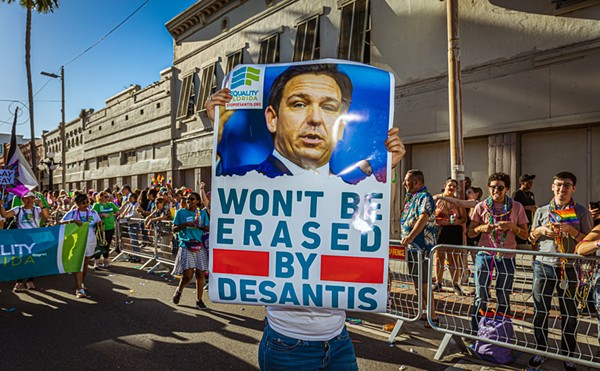
What is 300 feet long, bright yellow, resembles a beached whale and is hated by beach lovers across Pinellas County?
The canvas, sand-filled tubes on Upham Beach, that stretch of sand located between Pass-A-Grille and Corey Avenue in St. Pete Beach.
The tubes, called "geotextile T-groins," were placed on the beach in 2006 by the county to stem the rapid erosion of the beach. Residents of four condominiums on the north end of Upham called for the structures when erosion threatened their buildings and waves lapped into their lobbies.
But not everyone is sold on the idea.
Longtime St. Pete Beach residents wonder about the long-term effects of the structures.
"I recognize the damage those groins do to the pass," says George Manthos, chairman of the Beach Stewardship Committee. "In my 50 years here, I've been opposed to their construction."
Beachgoers find the tubes unsightly and dangerous.
"That beach is literally a death trap right now," says Mike Trvinski, who filed a lawsuit against the county this year after his children and 62-year-old father nearly drowned because of an undertow caused by the tubes.
Surfers lament the end to one of their favorite spots.
"[Upham Beach] was one of the best surf breaks on the Gulf of Mexico, and the T-groins destroyed it," says Mike Meehan, a surfer who is leading a petition drive to have the tubes removed (about 1,400 signatures have been gathered so far).
Business owners worry about profits.
"There has been a definite downturn of tourism to the beach," says Lenny Stamos of Lenny's Surf Shop.
And nearby homeowners say the whole situation is unfair.
"We're using taxpayer money to protect someone's condo," says Eileen Limmerbrock, a 13-year resident of Treasure Island who often visits Upham Beach. "Do I get taxpayer money to protect my home?"
Other states don't like the tubes: North Carolina has banned them, and other states are in protracted court battles over the issue.
And some scientists, like 43 Western Carolina University professors, say T-groins don't work.
Even the coastal coordinator for Pinellas County opposed the T-groins at first. That is, until Upham condo owners convinced her otherwise.
Upham Beach's problems started more than 65 years ago, when county officials constructed a jetty on the south side of the Blind Pass Inlet that blocked sand from drifting down to Upham. In the 1960s, when developers built condominiums on the northern part of Upham Beach, officials extended the jetties and dredged the pass again, which prohibited any remaining sand from reaching Upham Beach.
The beach has been eroding rapidly ever since. In the '90s, state officials classified Upham as the most-eroded beach in the state.
For years, the preferred solution for erosion was sand renourishment (mostly paid for by federal dollars). But Upham's condo owners, believing their homes needed more permanent protection, presented petitions to the city and county in 2004 calling for T-groins.
At the time, Pinellas County's coastal coordinator Dr. Nicole Elko opposed these erosion controls. According to the minutes of a 2004 St. Pete Beach City Commission meeting, Elko was skeptical the sandbags would even work on a high-energy beach such as Upham. In addition, she noted the structures could become a "significant safety hazard." Funding was also an issue; the Army Corps of Engineers issued a report stating the T-groins would be a waste of money and refused to fund them.
Yet, later that year, county and state officials approved $1.5 million to construct five T-groins on the north end of the beach.
(When asked about her earlier comments, Elko says she didn't think the canvas T-groins would last and preferred rock T-groins.)
Today, Elko maintains the sand-filled tubes are working. She points to data collected by her alma mater, the University of South Florida, which found there has been less erosion since the county constructed them. But the tubes have not stopped the erosion; the county has already renourished the beach once and another load of sand is scheduled for 2009. Still, Elko insists the T-groins are "saving money."
At what cost? Some beachgoers, like Mike Trvinski, say the T-groins create a treacherous rip current close to shore. That's what trapped his children and their grandfather underwater against a T-groin. Trvinski rescued them, but refuses to go back to the beach. Trvinski insists he's not seeking monetary damages from his February lawsuit against the county, only removal of the tubes.
"The city needs to start balancing band-aid approaches and ill-conceived plans with human life," he says.
Critics contend additional sand renourishment would better than unsightly and dangerous T-groins, but neither city nor county officials will broach the subject in meetings.
"Nobody really likes [the T-groins], but nobody really wants to do anything about them," says Stamos, the surf shop owner.
Elko, from the county, says the T-groins were originally supposed to last until 2012 and then be replaced by a permanent rock structure. Because of the increased public pressure, she suggests the rock jetty may come as early as next year.
But the surfers says that's not an option.
"You don't have to be a Ph.D. to know granite is more dangerous than canvas," says Meehan. "Teachers are losing jobs, police are losing jobs, and these people want us to spend tax dollars to set up permanent rock jetties?"














